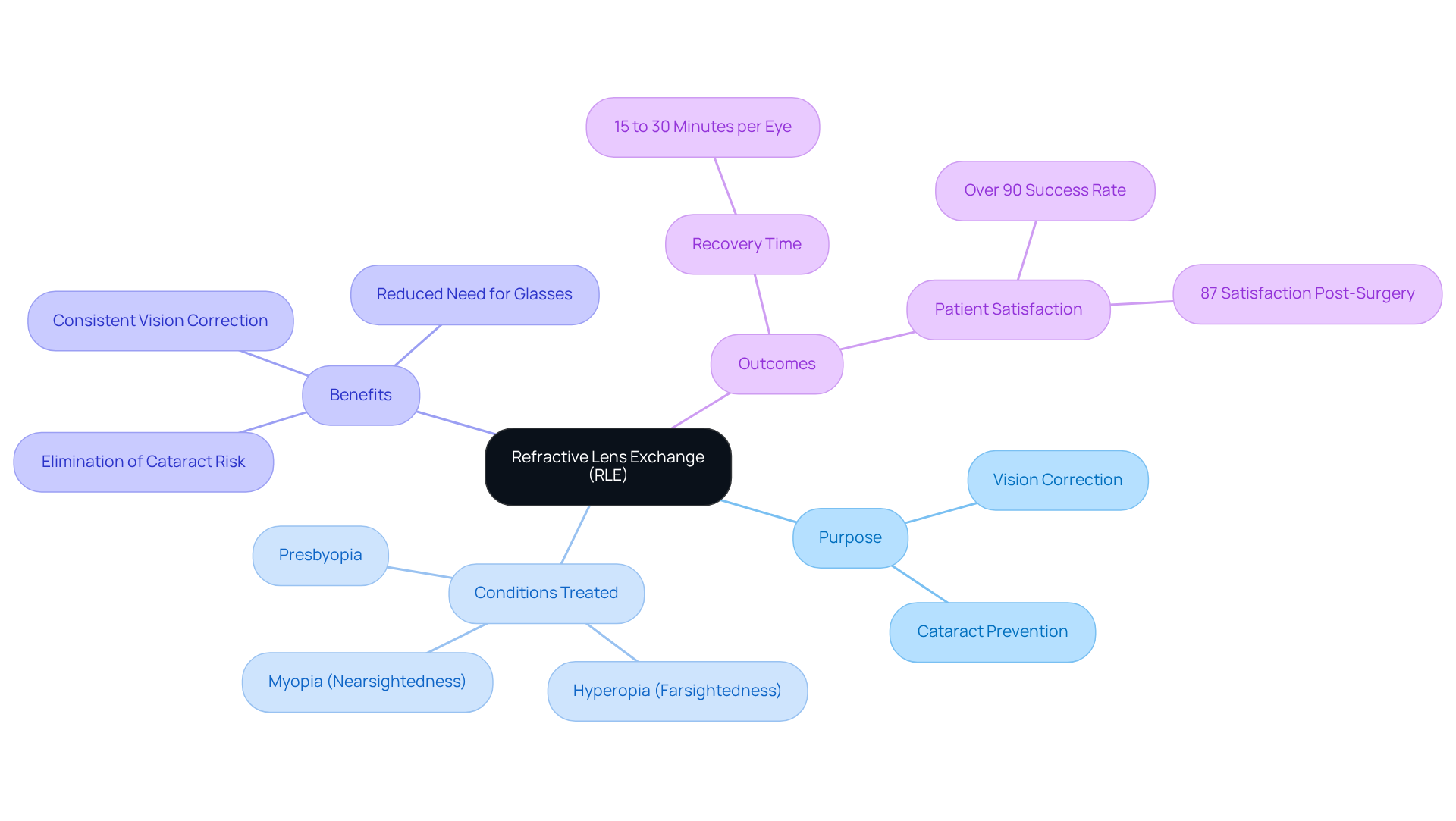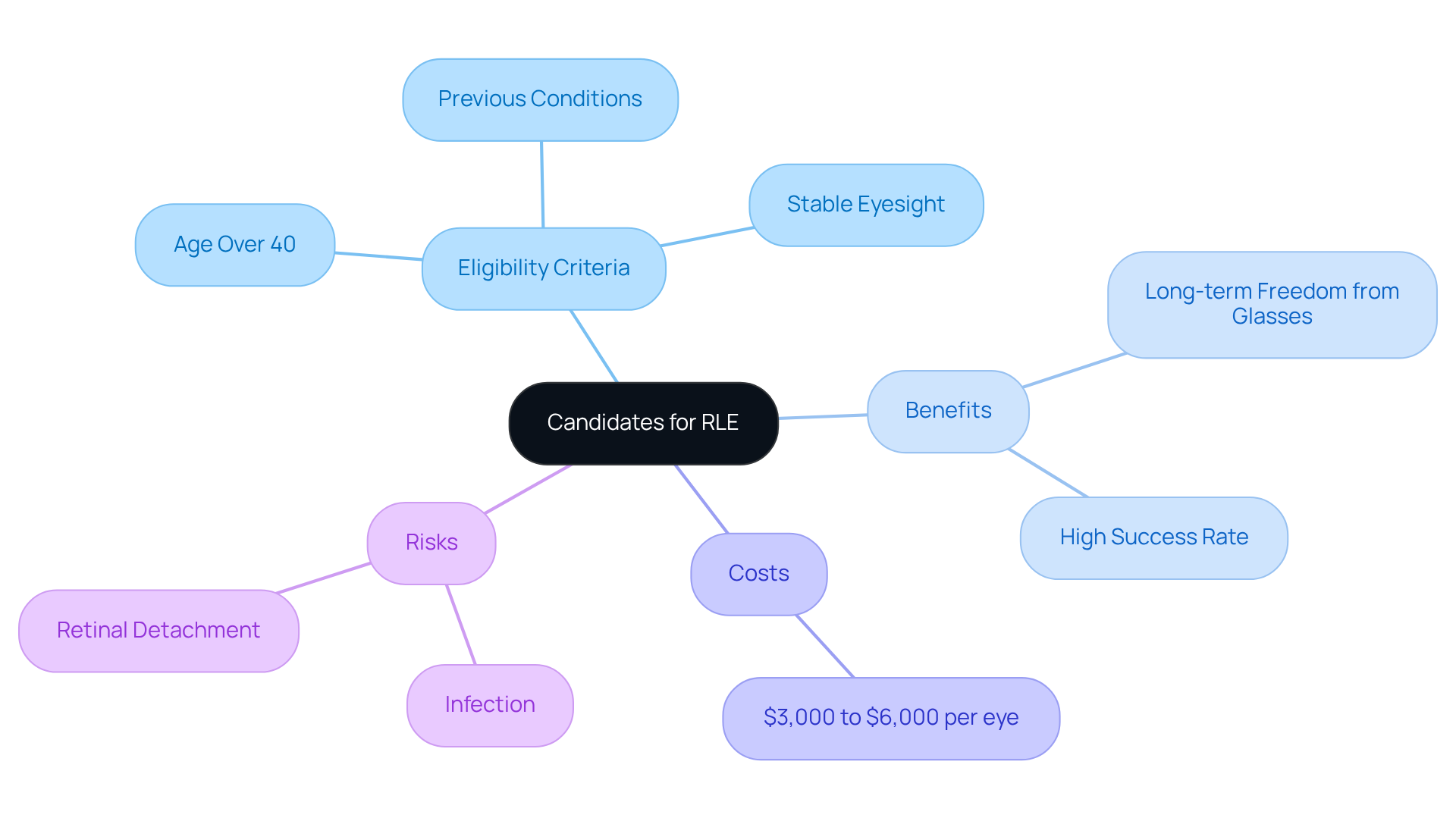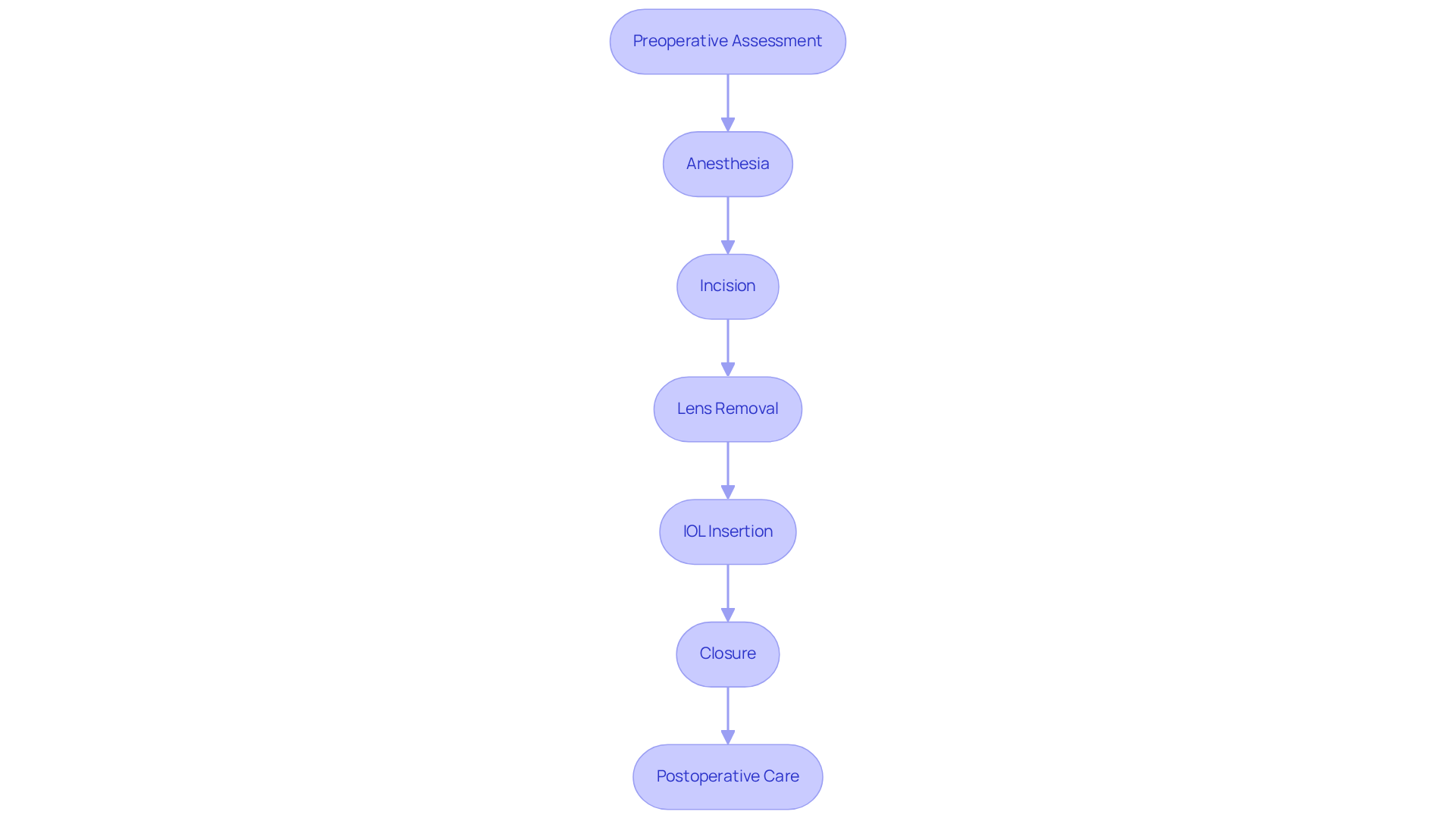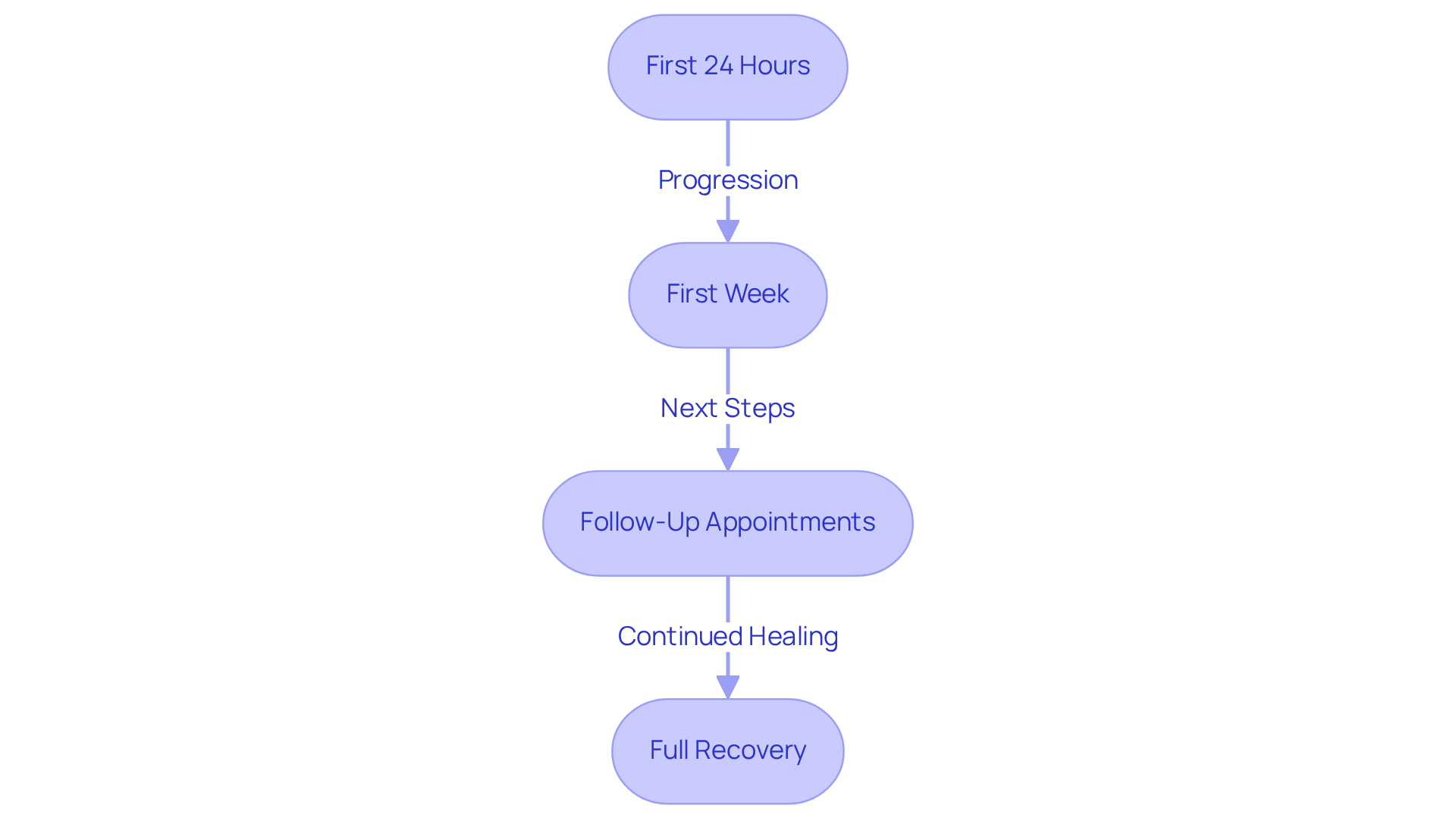Posted by: Northwest Eye in General, Vision Correction on July 28, 2025
Overview
Refractive Lens Exchange (RLE) is a surgical procedure designed to improve your vision by replacing the eye’s natural lens with an artificial intraocular lens (IOL). This procedure is particularly beneficial for individuals over 40 who may be experiencing refractive errors or early cataracts. We understand that considering surgery can be daunting, but RLE offers a promising solution.
This article details the RLE procedure, highlighting its advantages over LASIK. Many patients have reported high success and satisfaction rates, reinforcing RLE’s role as a long-term solution for vision correction. It’s common to feel uncertain about such decisions, but knowing that others have found relief and clarity can be reassuring.
We are here to help you through this process, providing the information you need to make an informed choice. Remember, your vision is important, and taking steps toward better sight is a courageous decision. You deserve to see the world clearly and beautifully.
Introduction
RLE eye surgery, or Refractive Lens Exchange, is transforming how individuals over 40 confront common vision challenges such as myopia, hyperopia, and presbyopia. We understand that navigating these changes can be daunting, but this innovative procedure not only enhances clarity but also eliminates the risk of cataracts, offering a long-term solution for improved eyesight.
With options like LASIK also available, it’s common to wonder: which procedure is the best fit for your unique needs? Exploring the nuances of RLE can illuminate its benefits, helping you make informed decisions about your eye health. We are here to help you through this process.
Define Refractive Lens Exchange (RLE) and Its Purpose
RLE eye surgery, which stands for Refractive Lens Exchange, is a surgical procedure designed to help you see more clearly by removing your eye’s natural lens and replacing it with an artificial intraocular lens (IOL). We understand that many individuals experience refractive errors like myopia (nearsightedness), hyperopia (farsightedness), and presbyopia, which is the difficulty in focusing on nearby objects as we age. Unlike LASIK, which reshapes the cornea, RLE eye surgery directly addresses the lens, making it an excellent option for those over 40 who may also be noticing early signs of cataracts.
One of the remarkable benefits of RLE eye surgery is its ability to not only enhance your vision but also eliminate the risk of developing cataracts in the future, as the natural lens is completely removed. The procedure typically takes about 15 to 30 minutes for each eye, and many people enjoy consistent sight correction, with numerous patients achieving 20/20 vision afterward.
RLE has become increasingly popular, thanks to advancements in lens technology and the growing aging population. This means we can tailor the results to significantly reduce or even eliminate your need for reading glasses or bifocals, ultimately improving your quality of life. According to Dr. Anthony Roberts, M.D., ‘RLE eye surgery is a highly effective, long-term solution for correcting eyesight, especially for individuals who may not qualify for LASIK due to age, refractive errors, or other eye conditions.’
It’s common to feel a bit anxious about surgery, but many individuals notice a substantial improvement in their vision within just days after the procedure. This makes RLE eye surgery an appealing choice for anyone looking for a dependable path to lasting vision correction. We are here to help you through this process and ensure you feel supported every step of the way.

Compare RLE and LASIK: Key Differences and Considerations
RLE eye surgery and LASIK are both effective eye correction surgeries, yet they cater to different individual needs and conditions. We understand that deciding on eye surgery can be daunting, so let’s explore these options together.
RLE eye surgery involves the removal of the natural lens and its replacement with an intraocular lens (IOL). This makes it particularly suitable for individuals over 40 who may be experiencing presbyopia or cataracts. Not only does RLE eye surgery rectify refractive errors, but it also greatly minimizes the likelihood of future cataract development, providing a more lasting solution for clear sight at all distances.
However, it’s important to note that RLE carries risks, such as malpositioned lenses, infection, and vision loss. We encourage you to discuss these potential risks with your ophthalmologist, who can provide personalized guidance.
In contrast, LASIK reshapes the cornea to address refractive errors and is generally recommended for younger individuals with stable prescriptions. The LASIK procedure is less invasive, enabling faster recovery, with many individuals returning to regular activities within just a couple of days.
It’s essential to understand that LASIK may not be suitable for those with high refractive errors or thin corneas. The cost of LASIK surgery typically ranges from $2,200 to $3,200 per eye, while the average cost of RLE eye surgery procedures is around $3,800 for a standard implant. Recent studies indicate that satisfaction rates are high for both procedures. RLE eye surgery achieves a success rate of over 95%, with 87% of patients expressing satisfaction shortly after the procedure. Similarly, LASIK patients also report high satisfaction, particularly regarding visual clarity and decreased reliance on corrective lenses.
When assessing these choices, we encourage you to participate in comprehensive discussions with your ophthalmologist. Together, you can examine your specific sight objectives, overall eye health, and the possible advantages and drawbacks linked to each procedure. Understanding these key differences and patient experiences can guide you in making informed decisions about your eye care. Remember, we are here to help you through this process.

Identify Candidates for RLE: Who Should Consider This Procedure?
If you’re over 40 and facing refractive errors like myopia, hyperopia, or presbyopia, you might be considering Refractive Lens Exchange (RLE). It’s common to feel uncertain about your options. Ideal candidates typically have stable eyesight, with no significant changes in their prescription for at least two years. If LASIK isn’t suitable for you due to thin corneas or other eye conditions, RLE can be a wonderful alternative.
We understand that making decisions about your eye health can be daunting. That’s why a thorough eye examination and a consultation with an ophthalmologist are essential. This helps evaluate your specific needs and determine if RLE is the right choice for you. Many people find RLE eye surgery especially beneficial as they seek long-term freedom from glasses or contacts, addressing common age-related vision issues.
RLE has a high success rate, with over 90% of individuals achieving 20/25 vision or better after surgery. However, it’s important to consider the average cost, which ranges from $3,000 to $6,000 per eye. We want you to feel informed and prepared as you weigh your options.
While RLE is generally safe, we encourage you to be aware of potential risks, such as infection and retinal detachment. Follow-up appointments are crucial for monitoring your recovery and assessing how well the procedure worked. Remember, we are here to help you through this process, providing support every step of the way.

Explain the RLE Procedure: Step-by-Step Overview
The procedure known as RLE eye surgery is a carefully orchestrated process designed to enhance vision and improve quality of life. We understand that considering surgery can bring about a mix of emotions, and we are here to guide you through each step of this journey. Here’s a step-by-step overview of what to expect during the surgery:
- Preoperative Assessment: A thorough eye examination is conducted to evaluate your suitability for RLE. This includes precise measurements of your eye’s anatomy and refractive errors to ensure optimal outcomes.
- Anesthesia: On the day of the surgery, anesthetic eye drops are applied to numb your eye, ensuring a comfortable experience.
- Incision: A small incision is made in the cornea, allowing access to the natural lens.
- Lens Removal: The natural lens is gently extracted using phacoemulsification, a technique that employs ultrasound waves to fragment the lens into smaller pieces for easier removal.
- IOL Insertion: An artificial intraocular lens (IOL) is then inserted into your eye, positioned precisely where the natural lens was located.
- Closure: The incision is self-sealing, typically eliminating the need for stitches.
- Postoperative Care: After a brief monitoring period, you will be discharged with specific aftercare instructions, including the use of prescribed eye drops to facilitate healing.
The whole process typically takes between 15 to 30 minutes for each eye and is conducted on an outpatient basis, enabling you to go home the same day. With high success rates reported, many individuals experience significant enhancements in their sight shortly after the surgery, often achieving 20/20 clarity or better. This transformative procedure not only enhances visual acuity but also empowers you to engage more fully in your daily activities. As Dr. Ruit emphasizes, ‘RLE eye surgery is a safe and effective procedure that can offer substantial benefits to individuals with high hyperopia, presbyopia, or borderline soon-to-be clinically significant cataracts who request this type of refractive surgery.’ We are here to help you through this process, ensuring you feel informed and supported every step of the way.

Discuss Recovery After RLE: What Patients Should Expect
Recovery after RLE is typically swift, and we understand how important it is for you to see improvements in your sight as soon as possible. Most individuals notice substantial enhancements within the first few days. Here’s what you can expect:
- First 24 Hours: It’s common to experience mild discomfort, blurry vision, and sensitivity to light. During this time, we recommend resting and avoiding strenuous activities to help your eyes begin to heal.
- First Week: Many individuals observe a significant enhancement in their vision. However, some may still face variations. Remember to use the eye drops prescribed by your surgeon as directed; these are essential for preventing infection and reducing inflammation. Most people can resume regular activities after a week, but if you’ve undergone surgery, you may need 1 to 3 days away from work to recuperate.
- Follow-Up Appointments: You will have follow-up visits to monitor your healing and assess your visual acuity. These appointments are crucial for ensuring that your eyes are healing properly and to address any concerns you may have.
- Full Recovery: While numerous individuals return to their regular activities within a few days, total healing may take several weeks, usually ranging from 2 to 6 weeks. It’s important to avoid rubbing your eyes and to follow all post-operative care instructions to ensure optimal results. We advise you not to drive for one week after lens replacement surgery.
Overall, RLE eye surgery offers a promising solution for vision correction. Understanding the recovery process can help you navigate this important phase with confidence. Remember, we are here to help you through this process.

Conclusion
RLE eye surgery, or Refractive Lens Exchange, offers a transformative solution for those experiencing refractive errors, particularly individuals over 40. By replacing the natural lens with an artificial intraocular lens, RLE not only enhances vision but also significantly lowers the risk of future cataracts. This procedure stands out as a viable alternative to LASIK, especially for candidates who may not be suitable for corneal reshaping due to age or other eye conditions.
Throughout this discussion, we shared key insights, including:
- The differences between RLE and LASIK
- The ideal candidates for RLE
- A detailed step-by-step overview of the surgical process
We also highlighted the swift recovery that many patients experience, with remarkable improvements in vision occurring within just a few days. With a high success rate and overall patient satisfaction, RLE eye surgery presents a promising option for those seeking a long-term solution to vision correction.
As you consider your options for eye surgery, it’s natural to weigh your personal circumstances and consult with an ophthalmologist to find the best path forward. The advancements in lens technology and the comprehensive nature of RLE make it a compelling choice for enhancing your quality of life through improved vision. Embracing this opportunity could lead to newfound freedom from glasses and contacts, ultimately enriching your daily experiences and interactions. We are here to help you through this process, ensuring you feel supported every step of the way.
Frequently Asked Questions
What is Refractive Lens Exchange (RLE) and what is its purpose?
Refractive Lens Exchange (RLE) is a surgical procedure that involves removing the eye’s natural lens and replacing it with an artificial intraocular lens (IOL) to improve vision. It is particularly beneficial for individuals over 40 who experience refractive errors such as myopia, hyperopia, and presbyopia, as well as those showing early signs of cataracts.
How does RLE differ from LASIK?
RLE involves the removal of the natural lens and its replacement with an IOL, making it suitable for older individuals or those with presbyopia or cataracts. In contrast, LASIK reshapes the cornea to correct refractive errors and is generally recommended for younger individuals with stable prescriptions. RLE addresses both refractive errors and minimizes future cataract risk, while LASIK is less invasive with a quicker recovery time.
What are the benefits of RLE eye surgery?
RLE eye surgery enhances vision and eliminates the risk of developing cataracts since the natural lens is removed. Many patients achieve consistent sight correction and can attain 20/20 vision after the procedure. It also significantly reduces or eliminates the need for reading glasses or bifocals, improving overall quality of life.
What are the risks associated with RLE?
Potential risks of RLE include malpositioned lenses, infection, and vision loss. It is important for patients to discuss these risks with their ophthalmologist to receive personalized guidance.
What is the typical duration of the RLE procedure?
The RLE procedure typically takes about 15 to 30 minutes for each eye.
What are the costs associated with RLE and LASIK surgeries?
The average cost of RLE eye surgery is around $3,800 for a standard implant, while LASIK surgery generally ranges from $2,200 to $3,200 per eye.
What are the satisfaction rates for RLE and LASIK procedures?
RLE eye surgery has a success rate of over 95%, with 87% of patients expressing satisfaction shortly after the procedure. LASIK patients also report high satisfaction, particularly regarding visual clarity and reduced reliance on corrective lenses.
How quickly can patients expect to see improvements in their vision after RLE?
Many individuals notice a substantial improvement in their vision within just a few days following the RLE procedure.






